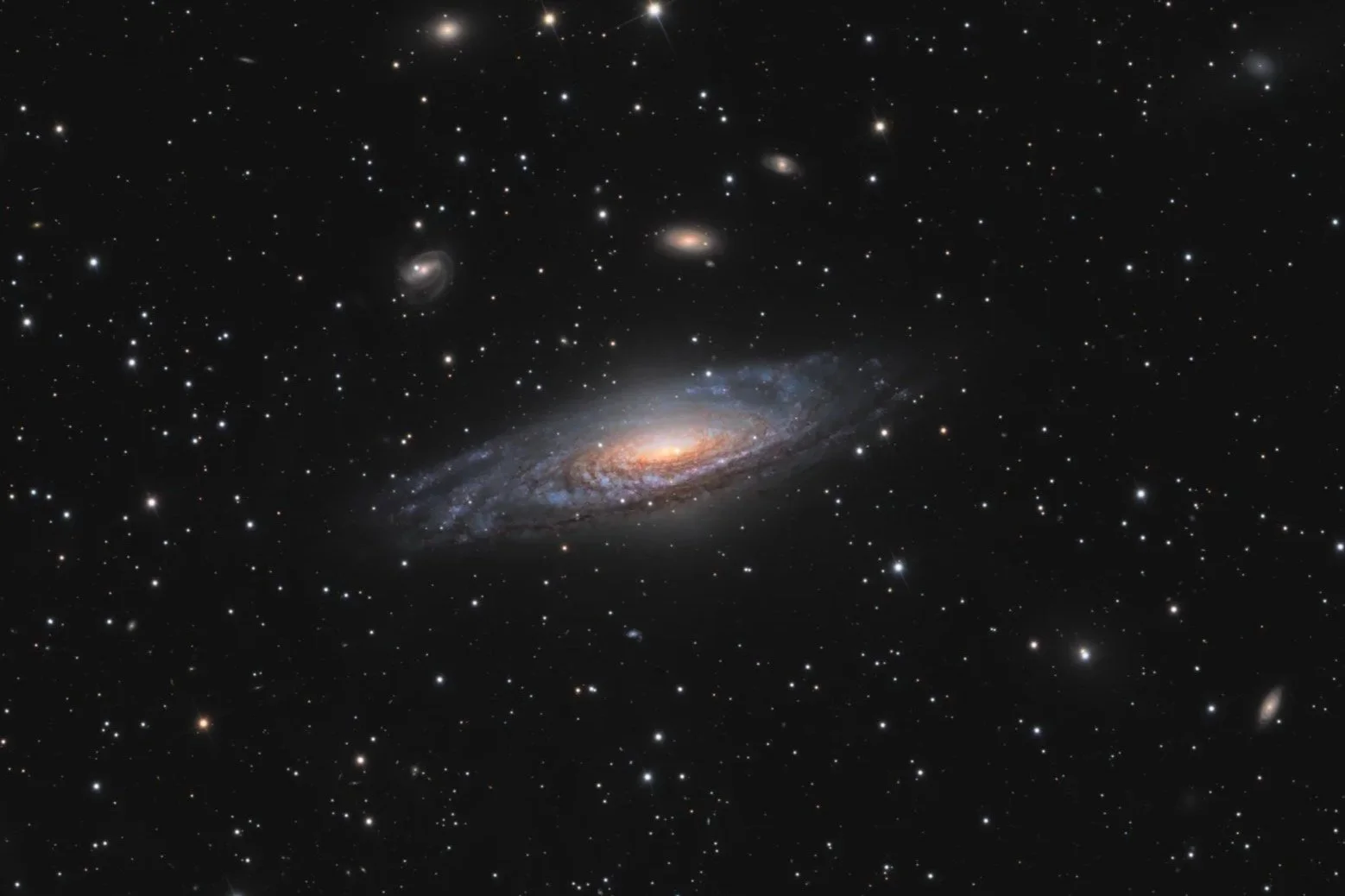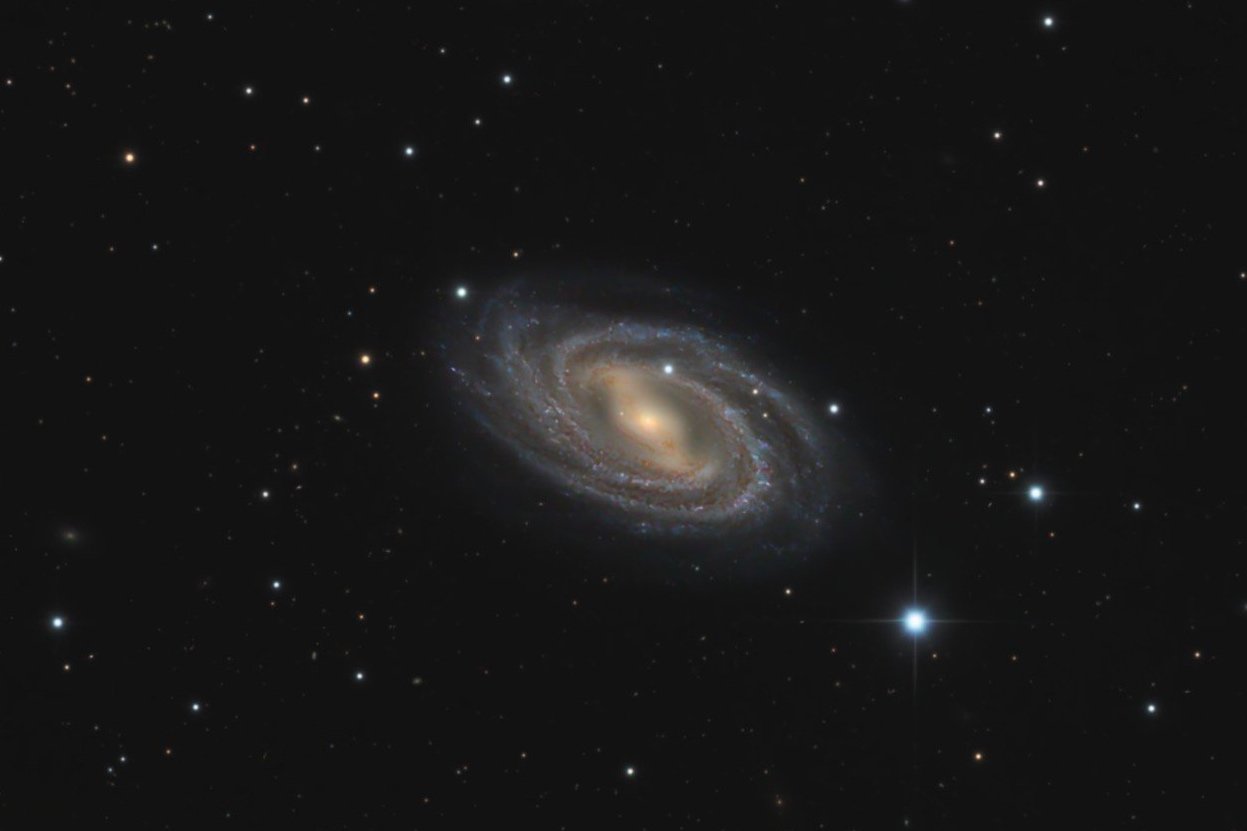
Images
Arp273
Arp 273 is a pair of interacting galaxies, 300 million light years away in the constellation Andromeda. The larger of the spiral galaxies, known as UGC 1810, is about five times more massive than the smaller galaxy, known as UGC 1813. It is thought that the smaller galaxy has actually passed through the larger one.
Caldwell 51
Caldwell 51, also known as IC 1613, is an irregular dwarf galaxy located on the outskirts of the Local group (the galaxy ground that includes our Milky Way) in the constellation of Cetus. Caldwell 51 was discovered in 1906 by Max Wolf, and is approaching Earth at 234 km/s.
Caldwell 43
Caldwell 43 (also known as NGC 7814 or UGC 8) is a spiral galaxy about 40 million light-years away in the constellation Pegasus. The galaxy is seen edge-on from Earth. It is sometimes referred to as "the little sombrero", a miniature version of Messier 104. The star field behind NGC 7814 is known for its density of faint, remote galaxies. It's among the few bright galaxies that exhibit modest distortion and twisting of the galaxy's plane in optical wavelengths.
Arp77
Arp77 consists of the larger barred spiral galaxy NGC 1097 and its smaller companion, the elliptical galaxy NGC 1097A. Located approximately 45 million light-years away in the constellation Fornax, these galaxies are engaged in a gravitational interaction that has visibly distorted their structures. NGC 1097, classified as a Seyfert galaxy, hosts an active galactic nucleus powered by a supermassive black hole, while the interaction with NGC 1097A has sparked intense starburst activity and created a striking ring of star formation around its core.
Caldwell 30
Caldwell 30, also known as NGC 7331, is an unbarred spiral galaxy about 43.79 million light-years away in the constellation Pegasus. It was discovered by William Herschel on 6 September 1784. The galaxy appears similar almost in size and structure to the Milky Way, and is sometimes referred to as "the Milky Way's twin".
M104
Messier 104, also known as the Sombrero Galaxy, is a peculiar galaxy of unclear classification in the constellation Virgo. It was discovered on May 11, 1781 by Pierre Méchain. Charles Messier made a handwritten note about this and five other objects (now collectively recognized as M104 – M109) to his personal list of objects now known as the Messier Catalogue, but it was not "officially" included until 1921.
M60 | Arp 116
Messier 60, is an elliptical galaxy approximately 57 million light-years away in the constellation of Virgo. Together with NGC 4647, it forms a pair known as Arp 116. NGC 4647 is an intermediate spiral galaxy. The galaxies are located on the outskirts of the Virgo Cluster. On 16 April, the Japanese amateur astrophotographer Kōichi Itagaki discovered a very bright Supernova, also known as SN 2022hrs.
Caldwell 21
Caldwell 21 is an irregular galaxy located approximately 12.5 million light-years away in the constellation Canes Venatici. It is part of the M94 Group, a collection of galaxies in the vicinity of the Milky Way. Caldwell 21 is notable for its active star formation, which is evident from the numerous young, blue star clusters and pinkish star-forming regions scattered throughout the galaxy.
M51 | Arp 85
Messier 51, also known as the Whirlpool Galaxy, is one of the most striking and well-known galaxies in the night sky. What makes it special is the interaction with nearby galaxy NGC 5195, distorting its otherwise symmetric spiral pattern. This gravitational pull has triggered waves of star formation in the Whirlpool's arms, lighting them up with clusters of hot, young, blue stars. Here in a long >60h exposure.
M58
Messier 58 is one of the brightest galaxies in the constellation Virgo. Located roughly 62 million light-years from Earth, M58 is the most distant Messier object. The core contains high rates of star formation, known as starburst activity. It also houses a supermassive black hole around 70 million times the mass of our Sun.
Arp 25, Arp 114
Arp 25 and Arp 114 are a spiral and an elliptical galaxy respectively in the constellation Cepheus, at a distance of about 120 million lightyears away from Earth. Their gravitational interaction causes distortions in their morphology.
M89
Messier 89 is an elliptical galaxy located in the Virgo Cluster, within the constellation Virgo. M89 is approximately 50 to 55 million light-years away from Earth and has an apparent magnitude of about 9.8 to 10.73. The galaxy contains around 100 billion stars and over 2,000 globular clusters.
Virgo Cluster
The Virgo cluster is a large area in the sky, packed with galaxies. The famous Markarian Chain may be the best known part of it, but there are many more pretty well visible galaxies around in the area. Explore this very wide-field recording of this exciting part of the night-sky.
M109
Messier 109 is a barred spiral galaxy located in the constellation Ursa Major, approximately 83.5 million light-years from Earth. It is one of the brightest galaxies in the Ursa Major Cluster. M109 is notable for its prominent central bar structure. The galaxy has a magnitude of about 9.8. It spans roughly 180,000 light-years in diameter, making it slightly larger than the Milky Way.
Arp41
Arp 41 is a grand design spiral galaxy located in the constellation Eridanus, approximately 60 to 65 million light-years away from Earth. It is part of Halton Arp's Atlas of Peculiar Galaxies, a catalog of unusual and distinctive galaxies. It includes a smaller, irregular companion galaxy, NGC 1232A, which appears to be interacting gravitationally with the main galaxy.




















